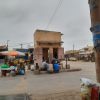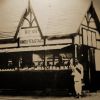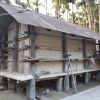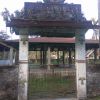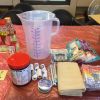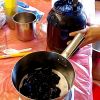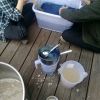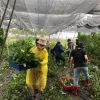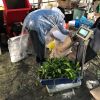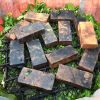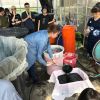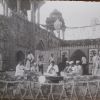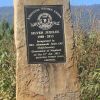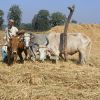The search found 237 results in 0.016 seconds.
Search results
La gare routière de Saint-Louis est un lieu oú transitent des centaines de voitures, ainsi que des miliers de personnes. A part les chauffeurs et les passagers, il y'a des employés et des vendeurs qui viennent y travailler tous les jours. Sur notre photo nous voyons, devant le poste de contrôle, six personnes entrain de partager un repas, autour d'un bol. Il y'a parmi eux des coxeurs (hommes qui organisent et tiennent la liste des véhicules et qui sont chargés de rabattre les clients vers un taxi ou un autocar), des agents de la mairie, et des chauffeurs.
Luntaya acheik means the silk thread woven in the method of acheik into the wavy rope pattern through the use of a hundred small shuttle looms. This acheik can be woven in silk only.
Pipariya Railway Station in district Hoshangabad, Madhya Pradesh, India was primarily established as the railhead for the Military Cantonment town of Pachmarhi. The present excerpt narrates the politics of everyday spaces at the station in the initial days. The excerpt has been translated from Hindi (Text: Pipariya, 2000 by Narayandas Maurya). The picture is only for representation purposes.
Story from an Intercommunity Dialogue on Rice Cultures and Cultivation
Ag lainai, the ritual of cutting the first fruits of paddy
Dharitri Narzary
Kaushalya has been selling laces in the Saturday weekly street market in Shadipur, West Delhi, for over 10 years. She is one of the very few women street vendors who make a living by selling various products across weekly markets in Delhi. In Shadipur Shani Bazaar, of the 350 plus street vendors only 10-12 of them are women.
Every mother tongue has sounds and sighs that utter laments and express hope. The word Ayaakho Ojala is derived from the Ao Indigenous tribal language and is the ultimate angst that is often invoked by women. It signifies a mother’s strength and comfort. As a woman utters it, she finds relief and rest from the pain of patriarchy that seeks to crush her down.
The Shadipur Shani Bazaar, known for the cheap and affordable stitched and pre-stitched fabric it offers, is one of the main attractions of the Shadipur neighbourhood. Spread entirely by word of mouth, the low prices at the market attracts customers from other parts of West Delhi, India. Hi-end boutique owners from Karol Bagh come here as well to buy fabric and bling to accessorise their products.
According to Bobby, a resident who sells children’s clothes in the market,
Suresh Godani (70), a resident of Pipariya, Madhya Pradesh, talks about the changing town-scape vis-à-vis the changes in local agricultural economy. A translated excerpt from our recorded conversation:
Bakhri II
The community Bakhri (Granary) at Thuribari, Kokrajhar, is one of the few such Bakhris seen nowadays in Assam. Community Bakhri is representative of a communal living and sharing. Located in an open village space just opposite the Brahma temple, these three small raised mud houses look ordinary but the significance and relevance of them in Thuribari community life is clearly visible from the well-maintained condition of it.
Many of us may have seen or bought indigo products from market. Seldom do we have the privilege to explore the beauty and hardship of a craftsmanship, know the process and knowledge of it from school. For the semester of Spring 2019, there is a course "Blue Across Boarders", which provided students a brief understanding of indigo, from plants, process of making indigo dye to dyeing, also provided them a chance to witness the process and experimented with dyeing by themselves in school.
Traditional handicrafts are a kind of embodied local knowledge, so does indigo. On the course of "Blue Across Boarders", students had a chance to talk with artisan Tang Wen-chun (湯文君), who is also an educator, motivator and researcher on indigo. Tang introduced the plants of indigo which are harvested in her farm, the practice she was conducting on also the process and tips for harvesting plants of indigo. Students had a field visit to the farm that grows the plants of indigo dye.
In urban and suburban Nagaland, as in many of the conflict-affected regions of India's North-East, such signs calling into action people and collectives are commonly visible. In this poster, the church as site of popular resistance is agency for mobilisation of constituencies such as the youth towards a unified struggle for the Naga nation.
Phool Walon Ki Sair meaning "procession of the florists" is an annual celebration by the flowers sellers of Delhi. It is a three-day festival, generally held just after the rainy season in the region of Mehrauli. The grand procession that followed Mirza Jahangir’s return in 1812 witnessed the flower sellers of the city bringing floral chadar (sheets) and pankha (fan) as offerings. This became an annual event, with a large fair and a series of cultural performances held near Shamsi Talab.
In the remote Naga hills , beyond the capital city of Kohima, stands the beautiful and historic village of Khonoma. Traditionally a site of resistance, having pushed back British rule in the region from the 1830s to 1880, Khonoma continues to be a space striving towards safeguarding the rights of women while strengthening Naga unity through organisations like the Khonoma Women Union, in whose honour this obelisk stands marking its 25 years in 2013.
The photograph, taken in the 1970s, shows Mohammad Anwar, an old time resident of Mehrauli, posing in front of the old Phasi Ghar in Mehrauli, Delhi. Today in place of this old structure stands the Jain temple named Ahinsa Sthal.
A farmer threshes his harvested crop in the village of Paliya Pipariya, Madhya Pradesh. In the age of combine harvesters, small scale farmers still rely on traditional methods such as bullock treading (seen in the picture) for threshing of crops, followed by winnowing. A common practice in many parts of the world, this particular method involves a herd of cattle tied to a wooden pole, made to tread in circles on the threshing floor where the dried crop is spread out.
Pages

